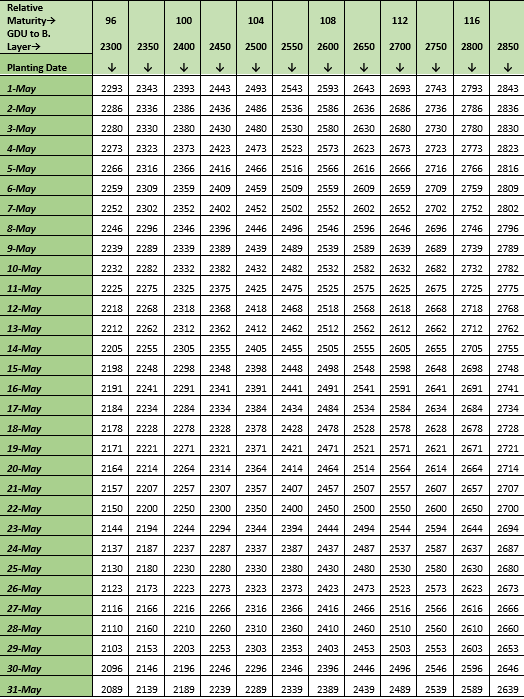- For each day past May 1st corn needs 6.8 GDU’s less to reach black layer.
- Know the average number of GDU’s accumulated for your area from the prospective planting date to the first killing frost.
- Consider the amount of time between the killing frost date and the estimated maturity date and its impact on hybrid dry-down.
- Generally, changing hybrid choices before the first week of June reduces yield potential more than sticking with original hybrid choices appropriate for a given maturity zone.
Corn:
The temptation to change crop management plans always exists in late planting seasons. Often the first thought is, “The planting season is getting late, and I need to change hybrids. If I don’t, my current choices won’t reach black-layer prior to the killing frost date in my area.” Is this the best approach? This article will examine corn hybrids, planting dates and how to determine if there is a need to switch hybrids.
Corn mainly responds to heat unit accumulation (Growing Degree Units or GDU’s) to move through its growth stages. However, in late planting situations hybrids can adjust their maturities. This is because corn does exhibit some sensitivity to the number of dark hours in a 24-hour period, which allows for those adjustments. Research from Purdue University found that for every day past May 1st, a corn hybrid decreases its GDU requirements to black-layer by 6.8 GDU’s per day. Refer to the table below for GDU adjustments for various GDU Black Layer requirements for hybrids sold throughout the Midwest (Figure 1).

Figure 1: GDU reductions to black-layer by planting date.
The next piece of information needed to make an informed decision is the average number of GDU’s accumulated for your location. You can calculate this by going to the U2U website (https://mygeohub.org/groups/u2u/purdue_gdd) (Figure 2). You can choose your location on the opening map and click “create GDD (growing degree day) Graph”. You then can change the start date for calculating GDD and select the three comparison years. Leave everything else alone and let it generate.

Figure 2: Example of Corn Growing Degree Day (GDD) calculation using the Useful to Usable (U2U) decision support tool for a 113-day hybrid in McClean Co. IL.
The location for the image above is McLean County, Illinois. The second light blue vertical line on the graph is the killing frost date (28⁰F for two hours) and this occurs around October 3rd on average. The number of heat units accumulated on average by that date from 1981-2010 is 2881 GDU’s. Going back to the table of values (Figure 1), a hybrid usually rated 2700 GDU’s to black layer with a planting date of May 10th would need approximately 2632 GDU’s to black layer. In this illustration, the long-term average of 1981-2010 provides 2881 GDU’s or an excess of 249 GDU’s, approximately 12 days in real-time at 20 GDU’s per day. While this is not a lot, the first black vertical line is the actual maturing date for a hybrid requiring 2787 GDU’s, ahead of the killing frost date.
The information in this example shows that even with a planting date of May 10th in McLean County, Illinois, a 113-day hybrid requiring 2715 heat units to black-layer would reach maturity nearly 2 weeks ahead of the first killing frost to dry-down. Experience tells us that the original hybrid choice is appropriate for the growing zone you farm in and that, based on the information shown above, changing hybrids is not necessary. Doing so could jeopardize yield at the expense of ROI per acre prior to the first full week of June in many areas.
Soybeans:
With regard to research conducted around earlier planting, we go back in time to the late 1990’s and early 2000’s to find later planting dates in trial research. The results show that even in early June, 80-93% of maximum soybean yield can be achieved with planting soybeans. As it pushes into mid-June, that spread gets even wider, 59-82% of maximum yield. Late planted soybeans require higher populations to compensate for fewer main stem nodes. Research from Purdue University suggests increasing seeding rates 10% per week of delayed planting in June. In central and northern climates, it is recommended to keep the maturity groups the same until we get into late June or early July. After we get into July, research suggests that shortening the maturity group by 0.5-1.0 would prove beneficial.
Changing hybrids and varieties is not a decision to be made without some thought and consideration. For additional guidance and support, reach out to your local FS Crop Specialist.
https://extension.entm.purdue.edu/newsletters/pestandcrop/article/late-planting-of-soybean/
Keywords: Corn, Soybeans Crop Management, Growth and Development, Emergence, Growing degree days, Maturity, Crop stage